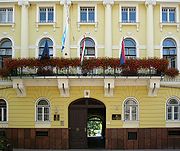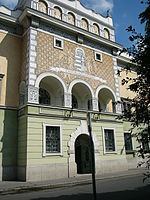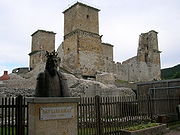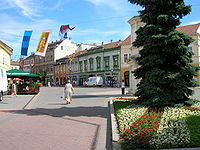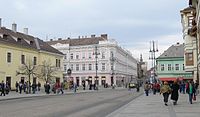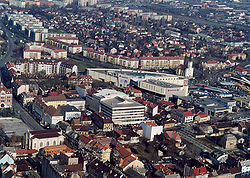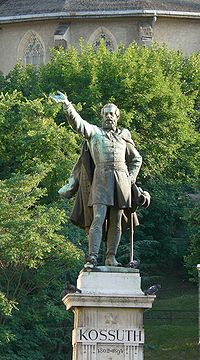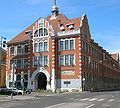- Miskolc
-
Miskolc 
Coat of armsNickname(s): Steel City; City of the Open Gates Location of Miskolc in Hungary Coordinates: 48°06′15″N 20°47′30″E / 48.10417°N 20.79167°ECoordinates: 48°06′15″N 20°47′30″E / 48.10417°N 20.79167°E Country Hungary Region Northern Hungary County Borsod-Abaúj-Zemplén Town since 1365 City since 1909 Urban county since 1970 Government – Mayor Ákos Kriza (Fidesz) Area – Total 236.68 km2 (91.4 sq mi) Population (2011) – Total 168,075 
– Density 756/km2 (1,958/sq mi) Time zone CET (UTC+1) – Summer (DST) CEST (UTC+2) Post code 3500–3549 Website www.miskolc.hu Miskolc (Hungarian pronunciation: [ˈmiʃkolts] (
 listen), Slovak: Miškovec) is a city in northeastern Hungary, mainly with heavy industrial background. With a population close to 170,000 (2010) Miskolc is the fourth largest city of Hungary (behind Budapest, Debrecen and Szeged; second-largest with agglomeration.) It is also the county capital of Borsod-Abaúj-Zemplén and the regional centre of Northern Hungary.
listen), Slovak: Miškovec) is a city in northeastern Hungary, mainly with heavy industrial background. With a population close to 170,000 (2010) Miskolc is the fourth largest city of Hungary (behind Budapest, Debrecen and Szeged; second-largest with agglomeration.) It is also the county capital of Borsod-Abaúj-Zemplén and the regional centre of Northern Hungary.Contents
Geography
Miskolc is located at 48°6′15″N 20°47′30″E / 48.10417°N 20.79167°E.
The city lies at the meeting point of different geographical regions – east from the Bükk mountains, in the valley of the river Sajó and the streams Hejő and Szinva. According to the 2001 Census the city has a total area of 236.68 km2 (91.38 sq mi). The ground level slopes gradually; the difference between the highest and lowest area is about 800 m (2,600 ft).
The lowest areas are the banks of the river Sajó, with an altitude of 110–120 m (360–390 ft). The area belongs to the Great Plain region and is made up of sedimentary rocks. Between the Avas hill and Diósgyőr lies the hilly area of the Lower Bükk (250–300 m/820–980 ft) consisting of sandstone, marl, clay, layers of coal, from the tertiary period, and volcanic rocks from the Miocene.
The Central Bükk, a gently sloping mountainous area with an altitude between 400 and 600 m (1,300 and 2,000 ft), is situated between Diósgyőr and Lillafüred; the area is made up of limestone, slate, dolomite and other rocks from the Triassic period. The surface was formed mostly by karstic erosions.
The highest area, the 600–900 m (2,000–3,000 ft) high Higher Bükk bore Bükk Highlands begin at Lillafüred. This mostly consists of sea sediments (limestone, slate, dolomite) from the Paleozoic and Mesozoic, and volcanic rocks like diabase and porphyry. Several caves can be found in the area. The city is also known for lowest measured temperature ever in Hungary with −35 °C (−31 °F).[citation needed]
Climate
Climate data for Miskolc Month Jan Feb Mar Apr May Jun Jul Aug Sep Oct Nov Dec Year Average high °C (°F) 0.0
(32.0)3.7
(38.7)10.1
(50.2)16.7
(62.1)21.6
(70.9)24.5
(76.1)26.5
(79.7)25.9
(78.6)22.0
(71.6)15.8
(60.4)7.4
(45.3)1.9
(35.4)14.68
(58.42)Average low °C (°F) −6.3
(20.7)−3.9
(25.0)−0.6
(30.9)4.3
(39.7)9.0
(48.2)12.3
(54.1)13.6
(56.5)13.0
(55.4)9.5
(49.1)4.5
(40.1)0.4
(32.7)−3.7
(25.3)4.34
(39.82)Precipitation mm (inches) 27
(1.06)28
(1.1)32
(1.26)40
(1.57)65
(2.56)83
(3.27)60
(2.36)65
(2.56)41
(1.61)34
(1.34)43
(1.69)36
(1.42)554
(21.81)Avg. precipitation days 5 6 6 7 9 10 8 7 5 5 7 6 81 Sunshine hours 40.3 70.0 127.1 177.0 223.2 225.0 254.2 235.6 180.0 142.6 54.0 37.2 1,766.2 Source: HKO History
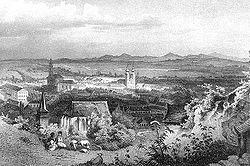 Historical picture of the city. View from the Avas hill with the Gothic church in the foreground. The church with two towers is the Minorite Church on today's Heroes' Square.
Historical picture of the city. View from the Avas hill with the Gothic church in the foreground. The church with two towers is the Minorite Church on today's Heroes' Square.
The area has been inhabited since ancient times – archaeological findings date back to the Paleolithic, proving human presence for over 70,000 years. Its first known dwellers were the Cotini, one of the Celt tribes. The area has been occupied by Hungarians since the "Conquest" in the late 9th century. It was named after the Miskóc clan and was first mentioned by this name around 1210 AD. The Miskóc clan lost their power when King Charles I centralized his power by curbing the power of the oligarchs.
Miskolc was elevated to the rank of oppidum (market town) in 1365 by King Louis I. He also had the castle of the nearby town Diósgyőr (now a district of Miskolc) transformed into a Gothic fortress. The city developed in a dynamic way, but during the Ottoman occupation of most of Hungary the development of Miskolc was brought to a standstill. The Turks burnt Miskolc in 1544 and the city had to pay heavy taxes until 1687. It was during these years that Miskolc became an important centre of wine-growing. By the end of the 17th century the population of the city was as large as that of Kassa, and 13 guilds had been founded.
During the war of independence against Habsburg rule in the early 18th century, Prince Francis II Rákóczi, the leader of the Hungarians put his headquarters in Miskolc. The imperial forces sacked and burnt the city in 1707. Four years later half of the population fell victim of a cholera epidemic. Miskolc recovered quickly, and another age of prosperity began again. In 1724, Miskolc was chosen to be the city where the county hall of Borsod county would be built. Many other significant buildings were built in the 18th and 19th centuries, including the city hall, schools, churches, the synagogue, and the theatre. The theatre is commonly regarded as the first stone-built theatre of Hungary, although the first one was actually built in Kolozsvár (then a part of Hungary, now Cluj-Napoca, Romania). According to the first nationally held census (1786) the city had a population of 14,719, and 2,414 houses.
These years brought prosperity, but the cholera epidemic of 1873 and the flood of 1878 took many lives. Several buildings were destroyed by the flood, but bigger and more beautiful buildings were built in their places. World War I did not affect the city directly, but many people died, either from warfare or from the cholera epidemic. She was occupied by Czechoslovak troops between 1918 and 1919 after the First World War.
After the Treaty of Trianon, Hungary lost Kassa (today Košice, Slovakia) and Miskolc became the sole regional center of northern Hungary. This was one of the reasons for the enormous growth of the city during the 1930s and 1940s. The preparation for World War II established Miskolc as the national centre of heavy industry, a position the city maintained until the 1990s. Although Miskolc suffered a lot during the last year of the war, it recovered quickly, and by absorbing the surrounding villages, it became the second-largest city of Hungary with more than 200,000 inhabitants. In 1949 the University of Miskolc was founded (as a successor of the Academy of Mining, formerly in Selmecbánya, which is now Banská Štiavnica, Slovakia).
During its long history Miskolc survived fires, floods, plagues and foreign invasions, but maintained its position as the centre of northeastern Hungary. The 1990s brought a crisis in the iron industry with a decline in the population.
Miskolc is now trying to become known as a cultural – instead of merely an industrial – city. Among the various cultural events, one of the most important festivities is the International Opera Festival, held in every summer.
The most popular tourist destinations in Miskolc are Tapolca, Lillafüred and Felsőhámor. Tapolca has a beautiful park with a boating pond and the famous and unique Cave Bath. Lillafüred and Felsőhámor are pretty villages in a valley surrounded by mountains and forests; their most famous sights are the Hotel Palace on the shore of the Lake Hámori, the Szinva waterfall (the highest waterfall of the country), the Anna Cave and the István Cave.
Historical population
Historical populations Year Pop. ±% 1786 14,179 — 1850 16,345 +15.3% 1870 21,199 +29.7% 1891 30,408 +43.4% 1900 61,160 +101.1% 1910 76,207 +24.6% 1920 85,151 +11.7% 1930 93,877 +10.2% 1941 114,674 +22.2% 1949 109,124 −4.8% 1960 143,903 +31.9% 1970 180,581 +25.5% 1980 207,303 +14.8% 1990 196,442 −5.2% 2001 185,567 −5.5% 2010 169,226 −8.8% 2011 168,075 −0.7% Economy
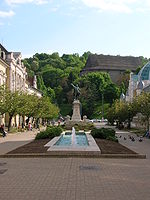 Erzsébet Square
Erzsébet Square
Miskolc is generally thought of as an industrial city, and the largest boost to its economy was indeed provided by the industrialization during the Socialist era; in fact industry (including metallurgy) has a long history in the city.
Miskolc was already an important market town in the Middle Ages, mostly due to its proximity to the main trade routes of the region. In regards of the economy, real development started only after the Ottoman occupation. In the 18th century, the town already had a lumber mill, a paper manufacture, a brewery, a gunpowder factory and fifteen mills on the Szinva stream. The glass works manufactures and iron furnaces appeared in the late 18th and early 19th centuries. The first iron furnace, built by Henrik Fazola around 1770, did not survive, but the second one, built in 1813, can still be visited. Several new settlements were formed in the Bükk mountains to provide dwellings for the workers of glass works manufactures and furnaces. Many of them – including Alsóhámor, Felsőhámor, Ómassa and Bükkszentlászló – are now parts of Miskolc.
Development quickened from the second half of the 19th century, partly because of the political situation (after the Ausgleich) and partly because of the newly constructed railway line. A large furnace (second largest in the country) was built in Diósgyőr, and several other factories were built. The mining industry became more and more important, too. Within forty years the population doubled. The industrialization led to the forming of Greater Miskolc with the unification of Miskolc and Diósgyőr (1945) and several nearby towns and villages (between 1950 and 1981). The unification was only the first step in Miskolc being developed into an industrial centre. Development reached its highest point in the 1980s, when the metal factory had more than 18,000 workers and production was over one million tons per year. The population hit all-time record (over 200,000 inhabitants), ⅔ of the working people worked in heavy industry.
The economical recession after the end of the Socialist era hit the industrial cities of Northern Hungary the hardest. The unemployment rate rose until it became one of the highest in the country, the population of Miskolc dramatically decreased (not only because of unemployment though, but also due to suburbanization which became prevalent nationwide). The economical situation of the city went through a change, smaller enterprises appeared in place of the large state-owned companies.
By the early 2000s the decade of changes was over, and the city went through the recession successfully. International companies and supermarkets appeared in the area. The local government is trying to strengthen the city's role in culture and tourism. By the end of 2004, the highway M3 had reached the city.
Sports
The most popular sport in Miskolc is the football. The leading club of the city is the Diósgyőri VTK [1] ( short name: DVTK). They won several times the Hungarian Cup and represented Hungary many times in Europe. The capacity of the stadium is 26,000 seats (15,000 is in use), but it is now in poor condition due to decay except for the new grand stand. The new board plans building of a new 15,000-seat stadium with under-soil heating and fully covered stands.
The other team, the MVSC plays in the county division. Miskolc has got other former first league representers, namely Attila FC Miskolc (7 seasons int the highest level), Pereces TK (1).
Miskolc has a famous women basketball team, called DKSK Miskolc MISI. It won The National Cup twice.
The Miskolc Ice-bears Hockey Team plays also in the first division. The Ice arena is in the People's Garden Downtown. It has 1,500 seats and was opened in 2006.
The women's volleyball team of MVSC plays at the highest Hungarian level also.
Speedway Miskolc joined the Polish Second League in 2005 and achieved serious results. They won the 2007 European Speedway Club Champions' Cup with World champion Jason Crump.
City parts of Miskolc
Avas
 Belfry of the Gothic church
Belfry of the Gothic church
The Avas is a hill (234 m/768 ft) in the heart of Miskolc. On the hilltop stands the Avas lookout tower, the symbol of the city. On the northern part of the hill, close to downtown Erzsébet Square, is the Gothic Protestant Church of Avas, one of the two oldest buildings of Miskolc (the other is the Castle of Diósgyőr.) The limestone caves of Avas are used as wine cellars; the narrow, winding streets give a Mediterranean atmosphere to this part of Avas Hill. The southern part of Avas, also called Avas-South, is where the largest housing estate of the city stands, with 10-story Socialist-style concrete buildings providing homes for about one-third of the city's population.
Belváros (City centre)
Miskolc's city centre is not as rich in monuments as that of other cities; only the Main Street (Széchenyi St.), Városház tér (City Hall Square) and Erzsébet tér (Elizabeth Square) have preserved the 19th-century style of the town. There are not only historical buildings but also modern shopping malls and offices in the city centre.
Diósgyőr
The other town forming today's Greater Miskolc is mostly famous for its medieval castle. Miskolc's football team also got its name from Diósgyőr, since their stadium stands there. Historical Diósgyőr is connected to Historical Miskolc by a district called Új(diós)győr (Újgyőr); its main square is an important traffic hub. Also in Új(diós)győr (Diósgyőr-Vasgyár) stands the steel factory that made Miskolc the most important heavy industrial city of Hungary (and earned it the nickname "Steel City").
Egyetemváros (University Town)
The University of Miskolc is among the newer ones. It was founded in the 1950s, so its buildings are not old, historical ones. University Town is one of the newer parts of the city and can be found between Miskolc and the holiday resort Miskolctapolca. The university, the campus and the sport facilities are surrounded by a large park.
Hejőcsaba and Görömböly
Two former villages that were annexed to the city in 1945 and 1950. Görömböly still looks like a small town of its own.
Lillafüred
The other famous holiday resort, Miskolc-Lillafüred is a picturesque village surrounded by the Bükk mountains. Its most famous building is the beautiful Palace Hotel (Palotaszálló).
Martin-Kertváros
Martin-Kertváros (in Slovak: Martinská osada) is a garden town area.
Miskolctapolca
One of the most well-known holiday resorts in the country, Tapolca (officially Miskolctapolca or Miskolc-Tapolca to avoid confusion with the Transdanubian town of the same name) is the home of the unique Cave Bath, a natural cave with thermal water. Tapolca is quite far from the city centre and counts as one of the posh areas of Miskolc. It is a popular tourist attraction.
Alsóhámor, Bükkszentlászló, Felsőhámor, Ómassa, Szirma
These former villages were annexed to the city in 1950 (Bükkszentlászló in 1981) and are still separated villages, connected to the city only by its public transport system.
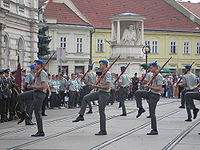 International Soldiers and Military Bands Festival.
International Soldiers and Military Bands Festival.
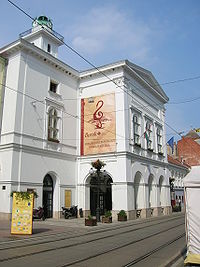 The National Theatre.
The National Theatre.
 Lillafüred, Palace Hotel.
Lillafüred, Palace Hotel.
Main sights
Downtown
- Main street and City Hall Square with the atmosphere of Hungarian towns of the 19th century
- Gothic Protestant Church of the Avas Hill
- Greek Orthodox Church with the largest iconostasis in Central Europe
- House of Arts with two art cinemas
- Kós House (designed by Károly Kós in Art Nouveau and folk style, 1931)
- Mindszent Church
- Minorite Church and Heroes' Square
- Miskolc-Avas TV Tower
- National Theatre of Miskolc
- Csodamalom Puppet Theatre
- Ottó Herman Museum
- Palace of Music
- Wooden Church
Diósgyőr
- Castle of Diósgyőr (built in the 13th century, had its prime during the reign of Louis the Great; medieval castle plays are held in every August)
- Lutheran church of Diósgyőr
- Protestant church of Diósgyőr (Baroque, built on the ruins of a mediaeval monastery)
Lillafüred
- Anna Cave, István Cave, Szeleta Cave
- Hotel Palace
- Lake Hámori
- Trout Farm
- Waterfalls (the highest one in Hungary)
There is a narrow-gauge railway that connects Lillafüred to Miskolc known as the Lillafüredi Állami Erdei Vasút (Lillafüred Forest State Railway). It winds through scenic forests, and takes between a half hour and 45 minutes for the train to go between the two major stops. The Miskolc stop is located in Diósgyőr.
Miskolctapolca
Near to the city
- Bánkút ski resort
- Bükk Mountains
- Miskolc Zoo
- Ruins of the monastery at Szentlélek
Festivals
- Diósgyőr Castle Plays (every May and August)
- International Soldiers and Military Bands Festival (every two years in August)
- Jelly festival (February)
- Miskolc Opera Festival (every summer)
- CineFest - International Festival of Young Filmmakers (every September)
Public transport
Main article: MVK Rt.Public transport in Miskolc is provided by the company MVK Zrt., owned by the local government. There are 36 bus lines and 2 tram lines. The first tram entered service on July 10, 1897 (making Miskolc the third city in Hungary to have a tram line), the first scheduled bus line started on June 8, 1903 (first in the country as well.) Today the public transport of Miskolc is one of the best ones in Hungary. There are several taxi companies too.
The Lillafüred Forest State Railway connects Diósgyőr to Lillafüred. It is mainly a tourist attraction.
The city has two railway stations (Tiszai and Gömöri) and a small unpaved airport, which is not open to the public, used mainly as a sports facility and has no role in public transport since 1963.
Famous people
Born in Miskolc
(Also includes people born in Diósgyőr and other city parts that were independent towns at the time of their birth.)
- Alan A. Brown (1928–2010) economist
- Alexander Grossmann (1909–2003) Swiss writer, journalist
- Andrei Şaguna (1809–1873) Romanian political leader, orthodox Metropolitan bishop of Transylvania
- Árpád Latabár sr. (1878–1951) actor
- Attila Repka (1968) wrestler, Olympic champion
- Bela Borsody Bevilaqua (1885–1962) Cultural historian
- Dániel Nyitray (1890–1971) painter, sculptor
- Dezső Gyarmati (1927) water polo player
- Ede Reményi (1828–1898) violinist
- Emeric Pressburger (1902–1988) Academy Award–winning movie director/writer/producer
- Ferenc Demjén (1941) singer
- Gábor Dayka (1769–1796) poet
- Gizella Bodnár, "Airplane Gizi" (1926–) thief
- Ilona Kállay (1930–2005) actress
- István Jónyer (1951) table tennis player
- István Prókai (1920–1983) actor
- Ladislau Raffinsky (1905–1981), Romanian football player
- Júlia Sebestyén (1981) figure skater, Europe champion
- Julius Leopold Klein (1810–1876) German writer
- Károly Grósz (1930–1996) politician, president
- László Palóczy (1783–1861) politician
- Lőrinc Szabó (1900–1957) poet
- Mária Keresztessy (1908–1977) actress
- János Nagyváthy (1755–1819) Hungarian journalist
- Máté Kamarás (1976) musical actor
- Miklos Kover (1975) controller, member of Holt Dog
- Péter Biros (1976) water polo player
- Péter Kropkó (1963) triathlonist
- Róza Laborfalvi (1817–1886) actress
- Sándor Ferenczi (1873–1933) psychoanalyst
- Sándor Lukács (1947) actor
- Sándor Rónai (1892–1965) politician, president
- Szabolcs Huszti (1983) football player
- Tamas Varro (1975) engineer, member of Miskolci Kan Korus
- Tibor Benedek (1911–1963) actor
- Vera Schmidt (1982) singer-songwriter
- Zoltán Dunai (1935) painter
- Zsigmond Fülöp (1935) actor
Lived in Miskolc
- Béla Kondor (Pestlőrinc, 1931 – Budapest, 1972) graphics artist
- Béni Egressy (Sajókazinc, 1814 – Budapest, 1851) composer
- Bertalan Szemere (Vatta, 1818 – Budapest, 1869) politician
- Didák Kelemen (Kézdialmás-Baksafalva, 1683 – Miskolc, 1744) Minorite monk, founder of Ferenc Földes High School
- Ferenc Bessenyei (Hódmezővásárhely, 1919 – Lajosmizse, 2004) actor
- Ferenc Pulszky (Eperjes, 1814 – Budapest, 1897) politician, archaeologist, writer
- János Lavotta (Pusztafödémes, 1764 – Tállya, 1820) composer, violinist
- József Lévay (Sajószentpéter, 1825 – Miskolc, 1918) poet, politician
- Lajos Szalay (Őrmező, 1909 – Miskolc, 1995) painter
- Leo Lánczy (Pest, 1852 – Budapest, 1921) deputy
- Margit Kaffka (Nagykároly, 1880 – Budapest, 1918) writer
- Menachem Josef Heimlich (Hajdu Bogasz, 1890 – Miskolc, 1925–1944) grand rabbi
- Ottó Herman (Breznóbánya, 1835 – Miskolc, 1914) ornithologist, polyhistor
- Pavol Országh Hviezdoslav (Felsőkubin, 1849 – Alsókubin, 1921) Slovak poet
- Robert Szucs (Toronto, 1974 - Miskolc, 1976–1989, teacher, social worker, member of Holt Dog and Miskolci Kan Korus
- Róza Széppataki-Déry (Jászberény, 1793 – Miskolc, 1872) actress
- Sándor Káli (Budapest, 1951) mayor
- Teréz Karacs (Budapest, 1808 – Békés, 1892) pioneer in women's education
- Zénó Terplán (Hegyeshalom, 1921 – Miskolc, 2002) fellow of the Hungarian Academy of Sciences
Gallery
Twin towns – Sister cities
See also: List of twin towns and sister cities in HungaryMiskolc is twinned with:
 Aschaffenburg, Germany
Aschaffenburg, Germany Białystok, Poland
Białystok, Poland Burgas, Bulgaria
Burgas, Bulgaria Cleveland, USA
Cleveland, USA Katowice, Poland
Katowice, Poland Košice, Slovakia, since 1997[1]
Košice, Slovakia, since 1997[1] Ostrava, Czech Republic
Ostrava, Czech Republic Tampere, Finland
Tampere, Finland Valenciennes, France
Valenciennes, France Vologda, Russia
Vologda, Russia Asan, South Korea
Asan, South Korea
See also
References
- Notes
- ^ "Partnership towns of the City of Košice" (in Slovak). © 2007-2009 City of Košice Magistrát mesta Košice, Tr. SNP 48/A, 040 11 Košice. http://www.kosice.sk/clanok.asp?file=gov_s_c-00.html. Retrieved 2009-07-12.
External links
- Official sites of the city and city parts
- Official website (Hungarian) (English) (German) (Polish) (Slovak)
- Official website of Lillafüred (Hungarian) (English) (German)
- Official site of Miskolctapolca (Hungarian) (English) (German)
- Webcams and image galleries
- Webcam view of downtown area (interactive cam)
- City Hall Square webcam
- Webcam view of Hotel Palace, Lillafüred
- Aerial photography: Miskolc
- Education and culture
- Official site of the Castle of Diósgyőr (Hungarian) (English) (German)
- Opera Festival (Hungarian) (English) (German)
- University of Miskolc
- Other
- Miskolc Online (Hungarian)
- Getting Medieval (an article in the Budapest Sun)
- Trams in Miskolc (English) (German)
Counties of Hungary Counties Bács-Kiskun · Baranya · Békés · Borsod-Abaúj-Zemplén · Csongrád · Fejér · Győr-Moson-Sopron · Hajdú-Bihar · Heves · Jász-Nagykun-Szolnok · Komárom-Esztergom · Nógrád · Pest · Somogy · Szabolcs-Szatmár-Bereg · Tolna · Vas · Veszprém · Zala
Urban counties Békéscsaba · Budapest (capital) · Debrecen · Dunaújváros · Eger · Érd · Győr · Hódmezővásárhely · Kaposvár · Kecskemét · Miskolc · Nagykanizsa · Nyíregyháza · Pécs · Salgótarján · Sopron · Szeged · Székesfehérvár · Szekszárd · Szolnok · Szombathely · Tatabánya · Veszprém · ZalaegerszegBorsod-Abaúj-Zemplén County County seat: MiskolcCities and towns Abaújszántó · Alsózsolca · Borsodnádasd · Cigánd · Edelény · Emőd · Encs · Felsőzsolca · Gönc · Kazincbarcika · Mezőcsát · Mezőkeresztes · Mezőkövesd · Nyékládháza · Ózd · Pálháza · Putnok · Rudabánya · Sajóbábony · Sajószentpéter · Sárospatak · Sátoraljaújhely · Szendrő · Szerencs · Szikszó · Tiszaújváros · Tokaj
Villages Abaújalpár · Abaújkér · Abaújlak · Abaújszolnok · Abaújvár · Abod · Aggtelek · Alacska · Alsóberecki · Alsódobsza · Alsógagy · Alsóregmec · Alsószuha · Alsótelekes · Alsóvadász · Arka · Arló · Arnót · Aszaló · Ároktő · Baktakék · Balajt · Baskó · Bánhorváti · Bánréve · Becskeháza · Bekecs · Berente · Beret · Berzék · Bodroghalom · Bodroghalász · Bodrogkeresztúr · Bodrogkisfalud · Bodrogolaszi · Bogács · Boldogkőújfalu · Boldogkőváralja · Boldva · Borsodbóta · Borsodgeszt · Borsodivánka · Borsodszentgyörgy · Borsodszirák · Bódvalenke · Bódvarákó · Bódvaszilas · Bózsva · Bőcs · Bükkaranyos · Bükkábrány · Bükkmogyorósd · Bükkszentkereszt · Bükkzsérc · Büttös · Csenyéte · Cserépfalu · Cserépváralja · Csernely · Csincse · Csobaj · Csobád · Csokvaomány · Damak · Dámóc · Debréte · Dédestapolcsány · Detek · Domaháza · Dövény · Dubicsány · Egerlövő · Égerszög · Erdőbénye · Erdőhorváti · Fáj · Fancsal · Farkaslyuk · Felsőberecki · Felsődobsza · Felsőgagy · Felsőkelecsény · Felsőnyárád · Felsőregmec · Felsőtelekes · Felsővadász · Filkeháza · Fony · Forró · Fulókércs · Füzér · Füzérkajata · Füzérkomlós · Füzérradvány · Gadna · Gagyapáti · Gagybátor · Gagyvendégi · Galvács · Garadna · Gelej · Gesztely · Girincs · Golop · Gömörszőlős · Göncruszka · Györgytarló · Halmaj · Hangács · Hangony · Harsány · Háromhuta · Hegymeg · Hejce · Hejőbába · Hejőkeresztúr · Hejőkürt · Hejőpapi · Hejőszalonta · Hercegkút · Hernádbűd · Hernádcéce · Hernádkak · Hernádkércs · Hernádnémeti · Hernádpetri · Hernádszentandrás · Hernádszurdok · Hernádvécse · Hét · Hidasnémeti · Hidvégardó · Hollóháza · Homrogd · Igrici · Imola · Ináncs · Irota · Izsófalva · Jákfalva · Járdánháza · Jósvafő · Kács · Karcsa · Karos · Kánó · Kány · Kázsmárk · Kelemér · Kenézlő · Keresztéte · Kesznyéten · Kéked · Királd · Kiscsécs · Kisgyőr · Kishuta · Kiskinizs · Kisrozvágy · Kissikátor · Kistokaj · Komjáti · Komlóska · Kondó · Korlát · Kovácsvágás · Köröm · Krasznokvajda · Kupa · Kurityán · Lak · Lácacséke · Ládbesenyő · Legyesbénye · Léh · Lénárddaróc · Litka · Mád · Makkoshotyka · Mályi · Martonyi · Mályinka · Megyaszó · Meszes · Mezőnagymihály · Mezőnyárád · Mezőzombor · Méra · Mikóháza · Mogyoróska · Monaj · Monok · Muhi · Múcsony · Nagybarca · Nagycsécs · Nagyhuta · Nagykinizs · Nagyrozvágy · Négyes · Nekézseny · Nemesbikk · Novajidrány · Nyésta · Nyíri · Nyomár · Olaszliszka · Onga · Ormosbánya · Oszlár · Ónod · Pamlény · Parasznya · Pácin · Pányok · Pere · Perecse · Perkupa · Prügy · Pusztafalu · Pusztaradvány · Radostyán · Ragály · Rakaca · Rakacaszend · Rásonysápberencs · Rátka · Regéc · Répáshuta · Révleányvár · Ricse · Rudolftelep · Sajóecseg · Sajógalgóc · Sajóhidvég · Sajóivánka · Sajókápolna · Sajókaza · Sajókeresztúr · Sajólád · Sajólászlófalva · Sajómercse · Sajónémeti · Sajóörös · Sajópálfala · Sajópetri · Sajópüspöki · Sajósenye · Sajószöged · Sajóvámos · Sajóvelezd · Sály · Sárazsadány · Sáta · Selyeb · Semjén · Serényfalva · Sima · Sóstófalva · Szakácsi · Szakáld · Szalaszend · Szalonna · Szászfa · Szegi · Szegilong · Szemere · Szendrőlád · Szentistván · Szentistvánbaksa · Szin · Szinpetri · Szirmabesenyő · Szomolya · Szögliget · Szőlősardó · Szuhafő · Szuhakálló · Szuhogy · Taktabáj · Taktaharkány · Taktakenéz · Taktaszada · Tarcal · Tard · Tállya · Telkibánya · Teresztenye · Tibolddaróc · Tiszabábolna · Tiszacsermely · Tiszadorogma · Tiszakeszi · Tiszaladány · Tiszalúc · Tiszapalkonya · Tiszatardos · Tiszatarján · Tiszavalk · Tolcsva · Tomor · Tornabarakony · Tornakápolna · Tornanádaska · Tornaszentandrás · Tornaszentjakab · Tornyosnémeti · Trizs · Újcsanálos · Uppony · Vadna · Vajdácska · Varbó · Varbóc · Vatta · Vágáshuta · Vámosújfalu · Vilmány · Vilyvitány · Viss · Viszló · Vizsoly · Zalkod · Zádorfalva · Zemplénagárd · Ziliz · Zsujta · ZubogyOther topics History · Geography · Government · Economy · Culture · TourismCategories:- County seats in Hungary
- Miskolc
- Populated places in Borsod-Abaúj-Zemplén county
Wikimedia Foundation. 2010.





